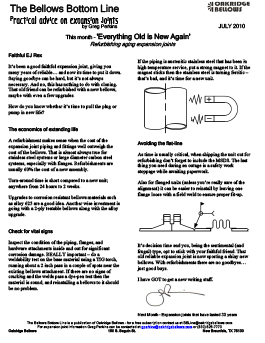Refurbishing Old Expansion Joints

Faithful EJ RexIt’s been a good faithful expansion joint, giving you many years of reliable… and now its time to put it down. Saying goodbye can be hard, but it’s not always necessary. And no, this has nothing to do with http://www.oakridgebellows.com/wp-admin/edit.php?post_type=ttshowcasecloning. That old friend can be refurbished with a new bellows, maybe with even a few upgrades.
How do you know whether it’s time to pull the plug or pump in new life?
The economics of extending life
A refurbishment makes sense when the cost of the expansion joint piping and fittings well outweigh the cost of the bellows. That is almost always true for stainless steel systems or large diameter carbon steel systems, especially with flanges. Refurbishments are usually 60% the cost of a new assembly.
Turn-around time is short compared to a new unit; anywhere from 24 hours to 2 weeks.
Upgrades to corrosion resistant bellows materials such as alloy 625 are a good idea. Another wise investment is going with a 2-ply testable bellows along with the alloy upgrade.
Check for vital signs
Inspect the condition of the piping, flanges, and hardware attachments inside and out for significant corrosion damage. REALLY important – do a weldability test on the base material using a TIG torch, running about a 2 inch pass in a couple of spots near the existing bellows attachment. If there are no signs of cracking and the welds pass a dye-pen test then the material is sound, and reinstalling a bellows to it should be no problem.
If the piping is austenitic stainless steel that has been in high temperature service, put a strong magnet to it. If the magnet sticks then the stainless steel is turning ferritic – that’s bad, and it’s time for a new unit.
*For original article with graphics click the PDF link attached below.
Avoiding the flat-line
As time is usually critical, when shipping the unit out for refurbishing don’t forget to include the MSDS. The last thing you need during an outage is a safety work stoppage while awaiting paperwork.
Also for flanged units (unless you’re really sure of the alignment) it can be easier to reinstall by leaving one flange loose with a field weld to ensure proper fit-up.
It’s decision time and you, being the sentimental (and frugal) type, opt to stick with your faithful friend. That old reliable expansion joint is now sporting a shiny new bellows. With refurbishments there are no goodbyes… just good buys.
I have GOT to get a new writing staff.


